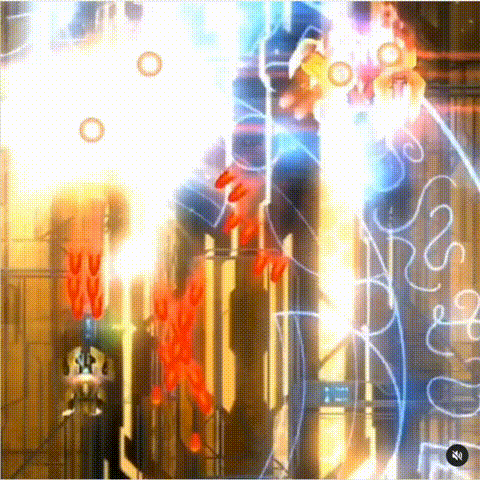MIRV
Fireworks bloom in the sky, very beautiful.
There are 3 types of MIRV turrets: launchers, spreads and bloomers. There are also 2 types of MIRVs, pellet MIRVs and laser MIRVs. Laser MIRVs have 2 tiers as well, I will refer T1 laser MIRVs as those that fire off 5 lasers, and T2 laser MIRVs as those that fire off 9 lasers (assuming each laser starts from the point of MIRV explosion).
- 圆锥曲线: It will definitely be a lot more interesting if you add the exploding sound effect "Boom~" to it.
Tiers and Patterns - MIRV Launchers




- Tier 1 (Figure 1): Fires 1 MIRV (bullet or T1 laser) forward each time
- Tier 2 (Figure 2): Fires 1 T2 laser MIRV or 2 bullet MIRVs forward each time
- Tier 3 (Figure 3): Fires 2 T2 laser MIRVs or 4 bullet MIRVs forward each time, scattering to both sides.
- Tier 4 (Figure 4): Fires 3 T2 laser MIRVs or 6 bullet MIRVs forward each time, scattering in three directions.
Trivia: Aside from laser and pellet MIRVs, there was apparently supposed to be a dart MIRV as well, which fired 24 singular darts in all directions. However, it never got past the testing stage. You can see it here:

Trivia: T1 and T2 laser MIRV have different appearances, T1 has 5 tentacles while T2 has 9.


Caged MIRV
Caged MIRV only appear in Major rank and above.
Super MIRV
The Super MIRV is produced by a turret similar to Doomsday MIRV, which produces one giant MIRV at a time. When you get close to it, this huge MIRV will split into 14 smaller MIRVs, and then the ordinary MIRV can explode into 30 bullets again, which is as annoying as a cluster bomb.
The currently known information is that the mother bomb (Super MIRV) itself cannot be cleared by a ult-level point defense laser, and can only be eliminated by other bullet-clearing skills (including ult-level Teleport's arrival EMP. But there is no conclusion yet on Point Defense's Bullet EMP laser APEX's effectiveness). Predictably, the Super MIRV can be thought of as a moving MIRV bloomer, with the later it is activated, the easier it is for bullets to gather in the lower half of the screen. Therefore, when the super MIRV appears, either activate it for a split second or don't get any closer until it flies off the screen.
Tiers and Patterns - MIRV Bloomers




- Tier 0 (Figure 1): Fire 6 MIRVs (bullets or Tier 1 laser) in all directions each time
- Tier 1 (Figure 1): Fire 8 MIRVs (bullets or Tier 1 laser) in all directions each time
- Tier 2 (Figure 2): Each time, 10 Tier 1 laser MIRVs or 12 bullet MIRVs are fired in all directions.
- Tier 3 (Figure 3): Each time, 16 Tier 2 laser MIRVs or 20 bullet MIRVs are fired in all directions.
- Tier 4 (Figure 4): Each time, 20 Tier 2 laser MIRVs or 30 bullet MIRVs are fired in all directions.
The MIRV Bloomer is a very threatening turret, sometimes even more impactful than the Doomsday turrets. They will shoot a large number of MIRVs at once, surrounding and blocking you. When you face a MIRV Bloomer, it is best not to activate the MIRVs one by one, but to activate a large number of MIRVs at once and then dodge.
For laser MIRVs, what you have to do is to activate as many as possible, and then find gaps in the laser array to avoid these lasers. This can effectively avoid the continuous blockage caused by activating the laser MIRVs one by one, and can also bring you a certain amount of energy. It should also be noted that these lasers can be reflected by the Personal Shield. The shield should be used at the intersection of multiple lasers, preferably where the laser MIRV is activated (this is equivalent to reflecting 5 or 9 lasers at a time).
For bullet MIRVs, especially Tier 3 or 4 MIRVs, if you are using Bullet EMP, be sure to learn to graze between the MIRVs. This is the most basic grazing action, which gives your energy, clearing all bullets on the screen at once, and resets all turrets. If your aura is not Bullet EMP, be careful, because you must have very solid dodging skills to get through a barrage composed of a large number of pellets.